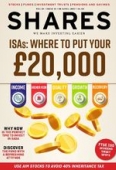Archived article
Please note that tax, investment, pension and ISA rules can change and the information and any views contained in this article may now be inaccurate.
This fund has a refreshing attitude to making money

Many fund managers believe their job is to beat a benchmark. That doesn’t necessarily mean they will make money for shareholders.
Think about a benchmark like the FTSE 250 index. If it falls 5% and a fund manager’s product only falls 2%, the latter would argue they have outperformed and therefore have done what they are paid
to do.
Strictly speaking they would be correct; but most investors would argue they aren’t paying a fund manager to lose money.
With this situation in mind, it can be refreshing to find a fund which doesn’t pin its fortunes on beating a particular index. The managers’ goal is to deliver positive total shareholder returns every year, which is growth in the value of the investment portfolio and cash payments in the form of dividends.
The fund in question is TB Saracen Global Income & Growth (GB00B3XPLG55) which looks around the world for its investment opportunities.
Admittedly it reports against two benchmarks: FTSE All-World (Sterling) and the Global Equity Income Sector. But deep down it doesn’t manage the fund with benchmarks in mind; it’s all about making money for investors.
Distancing itself from rivals
Some global funds aren’t as broad in coverage as you might think. For example, we’ve heard of some products that have more than half of their holdings tied to the US alone.
As for the Saracen fund, the latest data implies it has about a third in the US, a quarter in the Eurozone, 19% in the UK and a small bit in Japan, among others.
‘We don’t view the world by domicile; we care about companies’ sales and valuations,’ says Graham Campbell, co-manager of the fund.
Campbell says he ‘searches everywhere’ for companies, claiming to look at 110,000 firms a week. The current portfolio contains 45 stocks. The fund charges 0.97% a year and has a dividend yield circa 2.5%.
Rather than stressing the need to meet companies in person and look at their plants or factories when making an investment decision, Campbell is happy enough with the company accounts. His sweet spot is firms with a five year price to earnings ratio (PE) of less than 10-times.
The portfolio contains little known gems such as Anta Sports, a Chinese sportswear company that supplies the Chinese national basketball team among many others. This stock has a dividend yield of 3.2% and its share price has been in an upwards trend since 2012, apart from a short-lived blip in 2016.
Confident on healthcare
Pharmaceutical stocks are favoured by many income-style funds and predictably feature in Saracen’s fund.
Campbell likes pharma companies with access to emerging markets due to their growing middle class and subsequent increase in spending power. The fund has both AstraZeneca (AZN) and Pfizer in its portfolio partly due to their access to the Chinese market.
He’s also a pharma fan due to ageing demographics in many developed nations such as England, Germany and Japan, with the latter predicted to have over 120m people aged over 60 by 2020, according to Campbell.
Novo Nordisk caught Campbell’s eye when its share price retreated by 40% during the course of 2016. It is the biggest provider of insulin products for diabetics in the world.
Campbell bought Novo shares in the final quarter of last year, seeing an opportunity to buy cheaply at a time when the market appeared to have given up on the firm’s growth capability.
Close eye on cash
The fund manager pays close attention to a company’s cash position and cash generation capabilities in order to make a view whether it can comfortably pay dividends.
He sold Coca Cola mid-2015 after becoming concerned about cash generation. He says the famous brand’s dividend yield doubled and it was paying out 80% of earnings as dividends. ‘Earnings have gone nowhere and its debt has gone up.’
Campbell also sold Unilever (ULVR) at the end of 2015 as it had reached a level of valuation that could not be justified by the anticipated future level of earnings, in his view.
The fund has clearly reduced its exposure to consumer staples and is now increasing its position in areas such as technology and financials including positions in JP Morgan and Japanese firm Mizuho Financial.
Avoiding big losses
A strict sell discipline should be viewed as a positive factor. Many investors hold on to their investment too long when things go wrong, in the hope that problems will be fixed.
Saracen pays particular attention to potential losses it could incur on investments. It has ‘early warning signals’ when it reconsiders the investment case.
For example, it bought education group Pearson (PSON) in June 2011. At that time it had a strong balance sheet, decent dividend, market leading position and a fairly cheap valuation.
The fund sold in April 2015 just above £13 a share following US contract losses and increasing online headwinds. It was the right call as Pearson now trades at half this price.
This active approach leads to a fairly high turnover rate, namely the amount of stocks changed in the portfolio. Campbell says the figure is about 25% per year.
With a portfolio of 45 stocks, that’s over 11 firms lifted out a year – all of which will incur transaction costs.
Important information:
These articles are provided by Shares magazine which is published by AJ Bell Media, a part of AJ Bell. Shares is not written by AJ Bell.
Shares is provided for your general information and use and is not a personal recommendation to invest. It is not intended to be relied upon by you in making or not making any investment decisions. The investments referred to in these articles will not be suitable for all investors. If in doubt please seek appropriate independent financial advice.
Investors acting on the information in these articles do so at their own risk and AJ Bell Media and its staff do not accept liability for losses suffered by investors as a result of their investment decisions.
Issue contents
Big News
- Special dividend on cards for Central Asia Metals?
- FTSE 100 dividend delight on overseas earnings boost
- Margin pressure hits ASOS
- Polar Capital makes a mint after Miton raid
- Brace yourself for more British takeovers
- CityFibre seeks fresh funding deal
- Sophos shines and shares at record high
- Genus gets green light to launch GSS

 magazine
magazine










